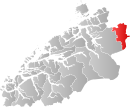Rindal Municipality
| Rindal kommune | |||
|---|---|---|---|
| Municipality | |||
|
|||
 Rindal within Møre og Romsdal |
|||
| Coordinates: 63°02′32″N 09°17′22″E / 63.04222°N 9.28944°ECoordinates: 63°02′32″N 09°17′22″E / 63.04222°N 9.28944°E | |||
| Country | Norway | ||
| County | Møre og Romsdal | ||
| District | Nordmøre | ||
| Administrative centre | Rindal | ||
| Government | |||
| • Mayor (2011) | Ola T. Heggem (Sp) | ||
| Area | |||
| • Total | 631.84 km2 (243.95 sq mi) | ||
| • Land | 611.10 km2 (235.95 sq mi) | ||
| • Water | 20.74 km2 (8.01 sq mi) | ||
| Area rank | 175 in Norway | ||
| Population (2013) | |||
| • Total | 2,061 | ||
| • Rank | 334 in Norway | ||
| • Density | 3.4/km2 (9/sq mi) | ||
| • Change (10 years) | -2.6 % | ||
| Demonym(s) | Rindaling | ||
| Time zone | CET (UTC+1) | ||
| • Summer (DST) | CEST (UTC+2) | ||
| ISO 3166 code | NO-1567 | ||
| Official language form | Neutral | ||
| Website | www |
||
|
|
|||
Rindal is a municipality in Møre og Romsdal county, Norway. It is part of the Nordmøre region. The administrative centre is the village of Rindal. The municipality centres on agriculture and forestry services. The municipality is the only landlocked municipality in the entire county.
The parish of Rindal was established as a municipality in 1858 when it was separated from Surnadal Municipality. The initial population of Rindal was 2,684. On 1 January 2008, the Fossdalen farm (population: 4) was transferred from Rindal (in Møre og Romsdal county) to Hemne Municipality (in Sør-Trøndelag county).
The municipality (originally the parish) is named after the old Rindal farm (Old Norse: Rindudalr), since the first church (Rindal Church) was built there. The first element is the genitive case of the river name Rinda and the last element is dalr which means "valley" or "dale". The river name is derived from the verb rinna which means to "run" or "flow". Before 1918, the name was written Rindalen.
The coat-of-arms is from modern times. They were granted on 20 January 1989. The arms show a yellow gavel on a green background. The gavel is meant to represent John Neergaard, who is considered the father of municipal governments in Norway, (formannskapets far), who was from Rindal. He was responsible for pushing for local government reform which led to the Formannskapsdistrikt law in 1837.
...
Wikipedia


